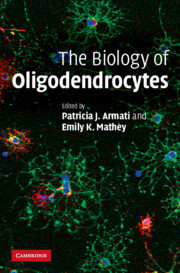Book contents
- Frontmatter
- Contents
- Preface
- Contributors
- 1 CNS oligarchs; the rise of the oligodendrocyte in a neuron-centric culture
- 2 Comparative biology of Schwann cells and oligodendrocytes
- 3 Control of oligodendrocyte development and myelination in the vertebrate CNS
- 4 Molecular organization of the oligodendrocyte and myelin
- 5 The genetics of oligodendrocytes
- 6 Immunobiology of the oligodendrocyte
- 7 Oligodendrocytes and disease: repair, remyelination and stem cells
- 8 Glial progenitor cells and the dynamics of the oligodendrocyte and its myelin in the aged and injured CNS
- 9 Oligodendroglial pathology in multiple sclerosis
- 10 Glutamate receptors, transporters and periventricular leukomalacia
- References
- Index
- Plate section
1 - CNS oligarchs; the rise of the oligodendrocyte in a neuron-centric culture
Published online by Cambridge University Press: 05 August 2012
- Frontmatter
- Contents
- Preface
- Contributors
- 1 CNS oligarchs; the rise of the oligodendrocyte in a neuron-centric culture
- 2 Comparative biology of Schwann cells and oligodendrocytes
- 3 Control of oligodendrocyte development and myelination in the vertebrate CNS
- 4 Molecular organization of the oligodendrocyte and myelin
- 5 The genetics of oligodendrocytes
- 6 Immunobiology of the oligodendrocyte
- 7 Oligodendrocytes and disease: repair, remyelination and stem cells
- 8 Glial progenitor cells and the dynamics of the oligodendrocyte and its myelin in the aged and injured CNS
- 9 Oligodendroglial pathology in multiple sclerosis
- 10 Glutamate receptors, transporters and periventricular leukomalacia
- References
- Index
- Plate section
Summary
If one desired to throw new light on the effect of disease, or injury, and of the process of healing in the brain, the best hope lay in the study of the non-nervous cells.
No Man Alone, Wilder Penfield, 1977 (Gill and Binder, 2007)NEUROGLIA
For the past 160 or so years the cells of the nervous system have been divided into two main categories: neurons and glia (Kettenmann and Verkhratsky, 2008). Prior to this, ever since the first image of a neuron was published in 1836 by Gabriel Valentin, the nerve cell had been in a class of its own (Lopez-Munoz et al., 2006). Some 20 years later in 1856 the term neuroglia was introduced by the German physician Rudolph Virchow. Virchow, also known as the “Pope of pathology” (Kettenmann and Ransom, 2005; Magner, 2002), described a “connective substance … in which nervous system elements are embedded” and referred to it as “nervenkitt” (or nerve putty). This description led to the use of the term “neuroglia,” which derives from archaic Greek, meaning something sticky or clammy. The notion that neuroglia were there merely as neural putty was treated with the reverence usually reserved for a bona fide papal encyclical and as such neuroglia remained sidelined for decades to come. Even though Virchow was responsible for the term neuroglia coming into use, at this stage he did not recognize that it was made up of cells rather than an acellular connective tissue.
- Type
- Chapter
- Information
- The Biology of Oligodendrocytes , pp. 1 - 18Publisher: Cambridge University PressPrint publication year: 2010

